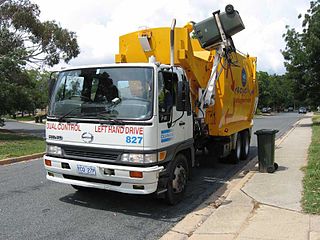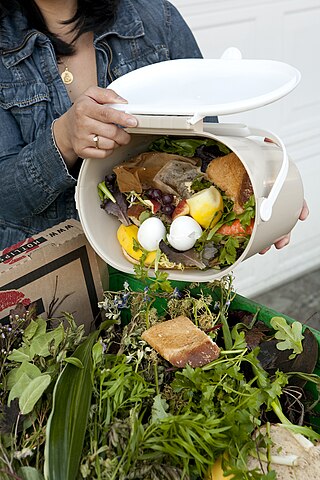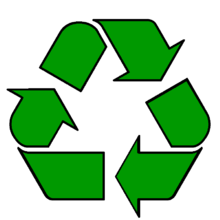
Recycling is the process of converting waste materials into new materials and objects. This concept often includes the recovery of energy from waste materials. The recyclability of a material depends on its ability to reacquire the properties it had in its original state. It is an alternative to "conventional" waste disposal that can save material and help lower greenhouse gas emissions. It can also prevent the waste of potentially useful materials and reduce the consumption of fresh raw materials, reducing energy use, air pollution and water pollution.

Waste management or waste disposal includes the processes and actions required to manage waste from its inception to its final disposal. This includes the collection, transport, treatment, and disposal of waste, together with monitoring and regulation of the waste management process and waste-related laws, technologies, and economic mechanisms.

A landfill is a site for the disposal of waste materials. It is the oldest and most common form of waste disposal, although the systematic burial of waste with daily, intermediate and final covers only began in the 1940s. In the past, waste was simply left in piles or thrown into pits.

Zero waste, or waste minimization, is a set of principles focused on waste prevention that encourages redesigning Natural resource resource life cycles so that all products are repurposed and/or reused. The goal of the movement is to avoid sending trash to landfills, incinerators, oceans, or any other part of the environment. Currently 9% of global Plastic recycling plastic is recycled. In a zero waste system, all materials are reused until the optimum level of consumption is reached.

A materials recovery facility, materials reclamation facility, materials recycling facility or multi re-use facility is a specialized waste sorting and recycling system that receives, separates and prepares recyclable materials for marketing to end-user manufacturers. Generally, the main recyclable materials include ferrous metal, non-ferrous metal, plastics, paper, glass. Organic food waste is used to anaerobic digestion or composting. Inorganic inert waste is used to make building materials. Non-recyclable high calorific value waste is used to making RDF and SRF.

Kerbside collection or curbside collection is a service provided to households, typically in urban and suburban areas, of collecting and disposing of household waste and recyclables. It is usually accomplished by personnel using specially built vehicles to pick up household waste in containers that are acceptable to, or prescribed by, the municipality and are placed on the kerb.

Waste diversion or landfill diversion is the process of diverting waste from landfills. The success of landfill diversion can be measured by comparison of the size of the landfill from one year to the next. If the landfill grows minimally or remains the same, then policies covering landfill diversion are successful. For example, currently in the United States there are 3000 landfills. A measure of the success of landfill diversion would be if that number remains the same or is reduced. In 2015 it was recorded that the national average of landfill diversion in the United States was 33.8%, while San Francisco had implemented the most effective policies and had recorded a landfill diversion rate of 77%.

This article outlines the position and trends of recycling in Canada. Since the 1980s, most mid to large municipalities in most provinces have recycling programs, relying on curbside collection with either bins, boxes, or bags. These systems are not standardized, and the specific process differs for each province. Certain provinces have container-deposit systems in place for bottles, cans, and other beverage containers.

In 2015, 43.5% of the United Kingdom's municipal waste was recycled, composted or broken down by anaerobic digestion. The majority of recycling undertaken in the United Kingdom is done by statutory authorities, although commercial and industrial waste is chiefly processed by private companies. Local Authorities are responsible for the collection of municipal waste and operate contracts which are usually kerbside collection schemes. The Household Waste Recycling Act 2003 required local authorities in England to provide every household with a separate collection of at least two types of recyclable materials by 2010. Recycling policy is devolved to the administrations of Scotland, Northern Ireland and Wales who set their own targets, but all statistics are reported to Eurostat.

The waste management in Switzerland is based on the polluter pays principle. Bin bags are taxed with pay-per-bag fees in three quarters of the communes. The recycling rate doubled in 20 years due to this strategy. The recycling rate for municipal solid waste exceeds 50 percent.
Waste management in Japan today emphasizes not just the efficient and sanitary collection of waste, but also reduction in waste produced and recycling of waste when possible. This has been influenced by its history, particularly periods of significant economic expansion, as well as its geography as a mountainous country with limited space for landfills. Important forms of waste disposal include incineration, recycling and, to a smaller extent, landfills and land reclamation. Although Japan has made progress since the 1990s in reducing waste produced and encouraging recycling, there is still further progress to be made in reducing reliance on incinerators and the garbage sent to landfills. Challenges also exist in the processing of electronic waste and debris left after natural disasters.

Municipal solid waste (MSW) – more commonly known as trash or garbage – consists of everyday items people use and then throw away, such as product packaging, grass clippings, furniture, clothing, bottles, food scraps and papers. In 2018, Americans generated about 265.3 million tonnes of waste. In the United States, landfills are regulated by the Environmental Protection Agency (EPA) and the states' environmental agencies. Municipal solid waste landfills (MSWLF) are required to be designed to protect the environment from contaminants that may be present in the solid waste stream.

Waste management laws govern the transport, treatment, storage, and disposal of all manner of waste, including municipal solid waste, hazardous waste, and nuclear waste, among many other types. Waste laws are generally designed to minimize or eliminate the uncontrolled dispersal of waste materials into the environment in a manner that may cause ecological or biological harm, and include laws designed to reduce the generation of waste and promote or mandate waste recycling. Regulatory efforts include identifying and categorizing waste types and mandating transport, treatment, storage, and disposal practices.

Source-separated organics (SSO) is the system by which waste generators segregate compostable materials from other waste streams at the source for separate collection.
Resource recovery is using wastes as an input material to create valuable products as new outputs. The aim is to reduce the amount of waste generated, thereby reducing the need for landfill space, and optimising the values created from waste. Resource recovery delays the need to use raw materials in the manufacturing process. Materials found in municipal solid waste, construction and demolition waste, commercial waste and industrial wastes can be used to recover resources for the manufacturing of new materials and products. Plastic, paper, aluminium, glass and metal are examples of where value can be found in waste.

Taiwan has one of the most efficient recycling programs globally, with a 55% collection rate from households and businesses and a 77% collection rate from industrial waste in 2019. Taiwan’s high recycling rates are unattainable in most countries due to Taiwanese geographical advantages along with efficient waste processing technologies and systems.

The Hong Kong plastic shopping bag environmental levy scheme is an environmental levy scheme designed to reduce the manufacture and distribution of plastic shopping bags (PSBs) in Hong Kong. PSBs are made of materials that are not easily degradable. The extensive disposal of PSBs is putting stringent pressure on the very limited landfill capacity, thereby causing severe waste problems in Hong Kong.
China's waste import ban, instated at the end of 2017, prevented foreign inflows of waste products. Starting in early 2018, the government of China, under Operation National Sword, banned the import of several types of waste, including plastics with a contamination level of above 0.05 percent. The ban has greatly affected recycling industries worldwide, as China had been the world's largest importer of waste plastics and processed hard-to-recycle plastics for other countries, especially in the West.

Waste management in South Korea involves waste generation reduction and ensuring maximum recycling of the waste. This includes the appropriate treatment, transport, and disposal of the collected waste. South Korea's Waste Management Law was established in 1986, replacing the Environmental Protection Law (1963) and the Filth and Cleaning Law (1973). This new law aimed to reduce general waste under the waste hierarchy in South Korea. This Waste Management Law imposed a volume-based waste fee system, effective for waste produced by both household and industrial activities.

Waste management in Australia started to be implemented as a modern system by the second half of the 19th century, with its progresses driven by technological and sanitary advances. It is currently regulated at both federal and state level. The Commonwealth's Department of the Environment and Energy is responsible for the national legislative framework.



















